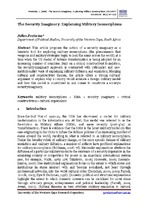| dc.contributor.author | Pretorius, Joelien | |
| dc.date.accessioned | 2012-10-30T13:31:07Z | |
| dc.date.available | 2012-10-30T13:31:07Z | |
| dc.date.issued | 2008 | |
| dc.identifier.citation | Pretorius. J. (2008). The Security imaginary: Explaining military isomorphism. Security Dialogue. 39(1): 97-118 | en_US |
| dc.identifier.issn | 0967-0106 | |
| dc.identifier.issn | 1460-3640 | |
| dc.identifier.uri | http://hdl.handle.net/10566/452 | |
| dc.description.abstract | This article proposes the notion of a security imaginary as a heuristic
tool for exploring military isomorphism (the phenomenon that
weapons and military strategies begin to look the same across the
world) at a time when the US model of defence transformation is
being adopted by an increasing number of countries. Built on a critical
constructivist foundation, the security-imaginary approach is contrasted
with rationalist and neo-institutionalist ways of explaining
military diffusion and emulation. Merging cultural and constructivist
themes, the article offers a ‘strong cultural’ argument to explain why a
country would emulate a foreign military model and how this model is
constituted in and comes to constitute a society’s security imaginary. | en_US |
| dc.language.iso | en | en_US |
| dc.publisher | Sage | en_US |
| dc.rights | This is the author postprint version of an article published by Sage. The file may be freely used, provided that acknowledgement of the source is given. | |
| dc.source.uri | http://dx.doi.org/10.1177/0967010607086825 | |
| dc.subject | Military | en_US |
| dc.subject | Security | en_US |
| dc.subject | Imperialism | en_US |
| dc.subject | Constructivism | en_US |
| dc.title | The Security imaginary: Explaining military isomorphism | en_US |
| dc.type | Article | en_US |
| dc.privacy.showsubmitter | false | |
| dc.status.ispeerreviewed | true | |
| dc.description.accreditation | Web of Science | en_US |

